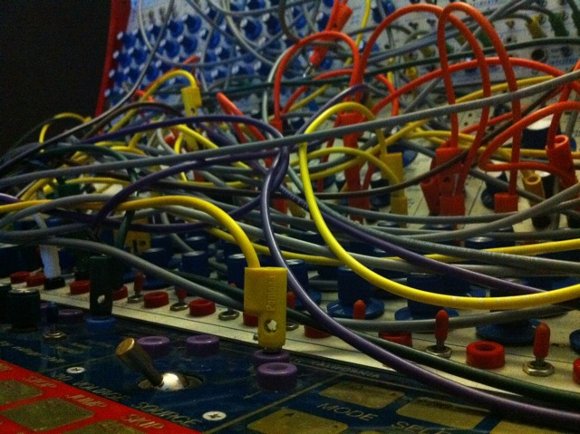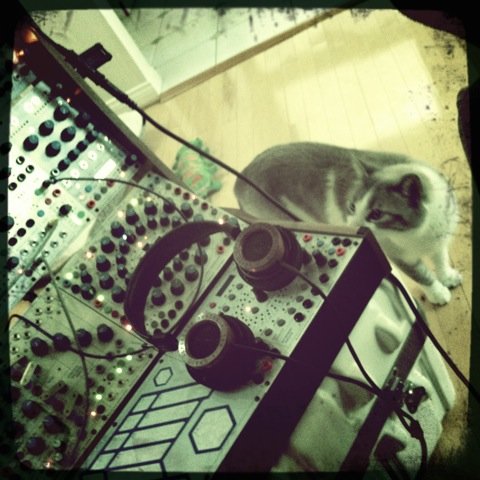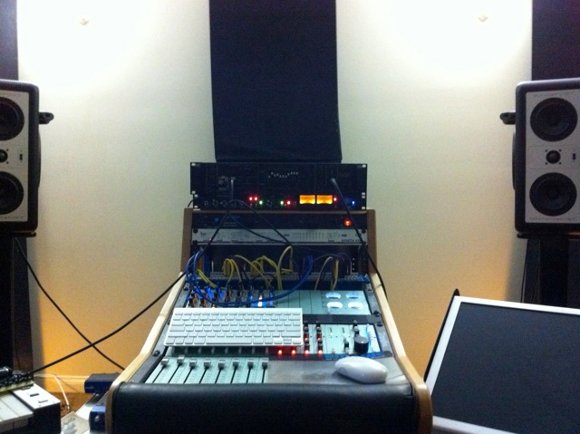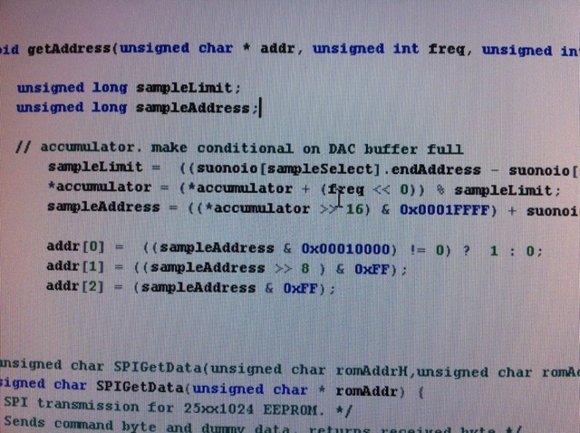
Call it cable addiction. Italian-born musician Alessandro Cortini, known for his live keyboard work with Nine Inch Nails, retreated into the studio with classic and contemporary Buchla modular synths to make “SONOIO.” Guided by his uniquely personal compositional style, he was able to wrangle that mess of chords and layers of analog sound into a genuine collection of beautifully-written songs, stacked high with Buchla timbral goodness.
The first four songs are free, with downloads starting at US$7.99 and physical records with bundled music at US$9.99 and up.
But SONOIO isn’t just a record release. The album itself is accompanied by a a portable synthesizer called the SuONOIO, custom-designed for the record by legendary synth maker The Harvestman (Scott Jaeger). I don’t think this is the first album release to have hardware alongside, but the SuONOIO itself is something special. Not just some toy or player, the creators endeavored both to incorporate the sounds of the album (via pitch-controlled sample players) as well as advanced features that allow you to make your own sounds. The synth, then, becomes a kind of art object reinterpretation of Alessandro’s own working method and tastes, building into an affordable, portable package his love of patch cords and sound tweaking.
All of this might be a stunt anywhere else. But quality and intent interferes: the album and synth alike could be major highlights of 2010. Via email, I talked to Alessandro about his creative process, his rig and how he attacked an all-modular album, and how he made the self-release and synth release work.
Yes, yes, “Create Analog Music.” (I’ve tried to go back and time to tell myself I should include a less literal name for the site, but my past self didn’t believe me.) But that’s the funny thing about it — this is a digital album. It’s also proof that the working techniques from the analog age — from doing recordings in a single take to treating the arrangement as a multitrack tape to patching sounds with chords — are just as relevant today in the world of the eight-core Mac Pro that did the final mix. And without the instinct to write songs, one Alessandro carries from childhood, it’s all just noise. Let’s let the artist explain.
http://www.sonoio.org/ [All purchases, from album to t-shirts to synth, plus free downloads]

On musical creation…
The sound world I think is what people will encounter first in this music, and generally in electronic music, so let’s begin there. How do you tend to think about timbre as you work?
I never know what I am going to write or create. That’s probably the main thing, to begin with.
I usually sit in front of an instrument to fiddle, to play with it like it’s a toy of some sort, hoping to come up with a sound unique enough to trigger an idea.
The idea can develop into a full composition, or stay as a simple two-hour time waster. Both results are very welcome, at all times!
The sense of the songwriting on the album to me is really strong. What’s your approach to assembling the songs, compositionally, particularly as many people tend not to associate sitting behind a Buchla modular with something like songwriting?
I have been writing songs since I was 7 years old. I started recording on a small boom box, with my voice only, making these tapes of songs I wrote for my grandparents to listen to on their way back home (they lived out of town).
I have been thinking of music in a song format as long as i can remember making music. Even the less song0based, more experimental work I released (i.e. blindoldfreak) still retains a song structure, even though it’s less obvious and instrumental, so to speak.
The thing is, I don’t really think about writing them. Each song comes from playing around with the instrument, in this case the Buchla. Sometimes it’s a sequence triggering a chord progression; other times, it’s a drone patch which triggers a melody in my mind.
For the SONOIO album, I tried to let the instrument dictate the structure. A song like “Just Me” doesn’t really have a repeating chorus, and it evolves through quite a few sections in the few minutes it lasts. I forced myself not to cut and paste anything. Everything in songs such as “Just Me,” “Not Worth Remembering,” and “Hold On Let Go” are one-takes, with the Buchla being multitracked and vocals/vocoder overdubbed.

How did that grow into the album, or what was the conception for the whole release?
The album started as soon as i realized that most of my “fiddling” with the modular was taking me into song territory, as opposed to more experimental [ground].
It took me a bit to realize that it would be great to try and write a whole collection of songs strictly on the modular, as opposed to layering instruments as I usually do, but when I committed to this process, things became challenging and refreshing at the same time.
The bulk of the album was written in January ’10, with most of the remainder of the time spent learning to mix it!
the “story” is really not that clear to me either, to be honest. I’ve always been attached to music that , even with a clear lyrical content, lends itself to personal interpretation, so i hope the listeners will take what they want from it.
What did you take away from your time with Nine Inch Nails? Did it impact your sound or the way you approach playing?
Of course it did — especially the time in the studio working on Ghosts. It was revelatory to see how much can come out of a single sound, if nurtured the right way. Also, those sessions taught me not to spend too much time over-thinking: if it sounds good, it’s time to move on.
I also learned that I don’t enjoy playing shows as much as I like being in a studio environment. There is something about the repetitivity of a live show that slowly erodes the magic of the songs. And while there are things you can do to keep it interesting for yourself — look at the spaceship that was my rig with NIN! — it eventually becomes a race to finish and get to the bus to sleep. It becomes the most feared thing: a real job.
What artists are inspiring you currently?
I don’t listen to a lot of commercial music these days, but here are a few of my current favorites: Belong, the last Telefon Tel Aviv album (amazing), Tim Hecker, BigBlackDelta, HEALTH, HowardAmb, Christopher Bissonette and pretty much anything on Kranky and Raster Noton.

Tools and Techniques
What’s your rig like in the the studio for this work?
The creative rig for this album (and for most of my work these days) is based around a Buchla 200 and a Buchla 200e More recently, I have been spending time with a keyboard version of the Monomachine [the SFX-6], which i use as an alternative writing tool.
The recording rig is a Mac Pro 2.26 octo [8-core], Logic Studio + [Apogee] Symphony system and a [Universal Audio] UAD card. It’s been the most stable and powerful rig I have ever had. Not one single crash during the sessions!
There’s a richly-layered, fat analog sound to the whole the mix. How do you balance all of these textures in a mix, and get everything to sit right?
Mixing was what took the longest to complete, and mostly because of the lack of experience/skills on my part. For a series of reasons, I decided to mix the album myself as opposed to outsourcing it, and I figured I would learn from the process, too.
I was lucky to have friends helping with suggestions and advice, including Jon from Big Black Delta who helped me when I got stuck in the vicious circle of “does this sound good enough?” Joshua Eustis from Telefon Tel Aviv was very helpful, too, in giving his feedback. His work on “Immolate yourself” is amazing … that album was a huge inspiration.
Another thing to keep in mind is that there aren’t many layers in each song. I would be surprised if I have more than 16 tracks running, total, including FX buses.
I usually stem out 8 outputs to my mini console, where I can mix the single elements as groups (1/2: effects, pads, drones, 3/4 vocoder, bkvox, 5: main vox, 6: bass, 7/8: drums/rhythmic elements).

An Independent Release, and Releasing a Whole Synth, Not Just a Record
What about the decision to self-release? How has the response been?
I didn’t [rule out] releasing through a label, in the beginning. The album was sent to various places I thought I would have liked to hear feedback from, but even the ones that were receptive were tied to a working schedule which turns days into months. The last thing I wanted to do is to release an album that was a year old, when I am ready to move onto new stuff the moment I master it.
I do miss the feeling of being part of family and some sort of financial support (which would have been limited, regardless, considering I am a newcomer), but I think I made the right decision to release it this way.
The album came out with the aid of the Topspin platform (http://www.topspinmedia.com/)
I took an online course at Berklee Music, since the tool itself didn’t make too much sense to me on its own, in the long run, without a proper marketing campaign and plan of action.
It’s something anybody can do, and not necessarily with Topspin. I chose them because I knew them as real music lovers, and great people I could communicate with and exchange ideas.
The audio player widgets, store buttons and email list/analytics are all their software, which I have learned to integrate in my own site, with the aid of a webmaster. (Phillip Farmer, http://crosshatch.net/)
And then you decide to release a full synthesizer to accompany the album. How did that come about?
I always wanted to release something that wasn’t necessarily a CD, vinyl, or similar, along with my music. I thought about it for a long time, and the synthesizer answer came quite naturally, a few months back.
My priority was to offer something that was unique (and a “first”, if possible), yet relates to who I am and what I do, not simply a publicity stunt of some sort.
How did you and Scott (The Harvestman) work together on the design?
Scott came to mind as the ideal candidate to solve my main problem with designing a synth (besides the fact that i don’t know how to design anything, of course…). How do I create something that is both related to the album AND allows [users] to create new and independent sounds and textures?
I contacted Scott and asked him if he’d be interested…we had a long and fruitful conversation over the phone and that’s how it began.
We then opened an email communication, exchanging ideas and concepts,which in no time led to a prototype.
What went into some of the design features of the synth? How did it evolve? I really like the cross-modulation capabilities and miniature patch cables.
The patch cable implementation idea came from Mike Brown of Livewire, who is a great friend of mine and Scott’s.
He suggested it, knowing it’d be a great way to extend my cable addiction to this instrument…and he was right!
The initial idea was to utilize carefully-selected sounds from the album and find a way to modulate them and make the, interesting with the minimal amount of controls. Scott’s knowledge in the field has allowed the instrument to evolve from this rather simple design to a much more expanded array of options, while retaining the “make sound immediately, no manual required” attitude.
We both wanted the instrument to be:
- Affordable: It’s roughly 160 $ (and even less if bought in the bundle with music, CD, poster, and shirt). We decided to skip the enclosure since it’s the most expensive part of the instrument, usually. BugBrand has pioneered this sort of design, I believe, and it was definitely an inspiration (I own a few of his clever instruments).
- Great looking: The final version’s colors will recall the album artwork, to a certain extent, so it’ll definitely belong to this particular release. In addition, we will create templates for paper/cardboard faceplates that the user can download, print and mount on the instrument. We both thought it’d be a great way to start a community to share designs, but mostly, I wanted mine to have cats on it so that’s why… There is also going to be an option to design aluminum faceplates and get them custom ordered somewhere else. We’ll provide the design and manufacturer’s contact info, if needed.
- Easy to play: There’s no keyboard (yet) for it, only 7 knobs and patch points. Even without patching, you can really mangle the built-in samples and turn them into something creative and different. If and when that will become obsolete, the user can take advantage of the 16 patchable points and add functions such as distortion, delay, FM destination and more. We wanted the instrument to be appealing to seasoned electronic musicians as well as people who had no idea of what it is, but are curious enough to pick it up and make noise.
- Easy to interface: It comes with a battery holder, 9V Boss AC connector, built-in speaker and 1/4″ audio output. It can also be connected to another SuONOIO instrument for further manipulation or to create more complex sounds.
How do you hope this instrument will be used, or what do you hope may come out of getting this in the hands of listeners? What does that mean for the listener/maker relationship? And could you see this idea catching on?
I hope to see people making music with it, or just using it as a hobby tool of some sort — as something you keep on the coffee table and play every now and then, or something you integrate in your state-of-the-art electronica rig.
I think it can be several things except a normal-sounding instrument, because that it is not!
The response has been overwhelming so far, both for the album and the instrument, thanks to the word of mouth of the online community and Trent Reznor who has been very supportive with spreading the word about SONOIO.
Thanks to Alessandro for sharing so much. More shots of his studio environment below.